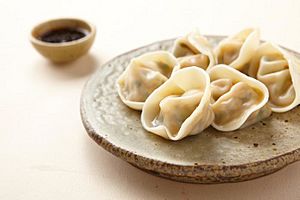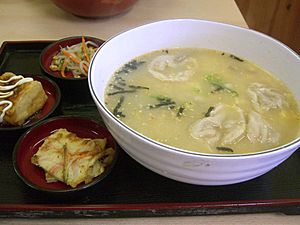Mandu (food) facts for kids

Jjin-mandu (steamed dumplings)
|
|
| Alternative names | Dumplings |
|---|---|
| Type | Fillled dumpling |
| Place of origin | Korea |
| Associated national cuisine | Korean cuisine Korean royal court cuisine |
| Similar dishes | |
| Korean name | |
| Hangul |
만두
|
|---|---|
| Hanja |
饅頭
|
| Revised Romanization | mandu |
| McCune–Reischauer | mandu |
| IPA | [man.du] |
Mandu (Korean: 만두; Hanja: 饅頭), also called mandoo, are tasty dumplings from Korean cuisine. You can find mandu in many forms. They can be steamed, boiled, pan-fried, or even deep-fried.
The way mandu are made can also be different depending on where you are in the Korean Peninsula. For a long time, mandu were a special dish served in Korean royal court cuisine. Today, you can easily find them everywhere in Korea. Look for them in supermarkets, restaurants, and snack spots like pojangmacha (street food stalls) and bunsikjip (casual eateries).
Contents
What's in a Name?
The name Mandu is connected to similar dumplings found along the famous Silk Road. This ancient trade route connected many cultures. You can find similar names and foods in Central Asia. For example, there's Uyghur manta (مانتا) and Turkish mantı. Kazakh mänti (мәнті) and Uzbek manti are also related. Even Afghan mantoo and Armenian mantʿi (մանթի) share this connection.
Chinese mántou (馒头; 饅頭) is also a related word. Long ago, mantou meant dumplings filled with meat. But now, it usually means steamed buns that don't have any filling.
Mandu can be put into two main groups: gyoja (교자; 餃子) and poja (포자; 包子). In Chinese, these types of dumplings are called jiǎozi (饺子; 餃子) and bāozi (包子). These Chinese names are similar to the Korean ones. In Japan, the first type of dumpling is called gyōza (餃子), which is also a related word. The Mongolian buuz (бууз) is similar to the poja type.
A Bite of History
People believe Mandu first arrived in Korea in the 14th century. This was during the Goryeo dynasty, when Yuan Mongolians visited Korea. At that time, the main religion in Goryeo was Buddhism. Buddhism often encouraged people not to eat meat.
However, when the Mongolians came, they brought new dishes that included meat. Mandu was one of these new foods. This helped to relax the rules about eating meat.
Another idea is that Mandu came to Korea much earlier. It might have traveled from the Middle East along the Silk Road. Historians think many wheat-based foods, like dumplings and noodles, started in Mesopotamia. From there, they slowly spread. As these foods moved east along the Silk Road, many different versions of mandu appeared across Central and East Asia.
There's even an old Goryeo folk song called "Ssanghwajeom." This song tells a story about a mandu shop. The shop was run by a foreigner, who was probably from Central Asia. The word ssanghwa in the song means 'dumplings', and jeom means 'shop'.
Different Kinds of Mandu
Mandu can be prepared in many ways, and each way has its own name!
- Gun-mandu (군만두) are mandu that have been grilled or pan-fried until they are crispy.
- Jjin-mandu (찐만두) are mandu that are steamed. They can be steamed in a traditional bamboo steamer or a modern one.
- Mul-mandu (물만두) means "boiled mandu." These are soft and chewy.
- Gullin-mandu (굴린만두), also known as gulmandu, are special. They are shaped like balls and don't have a wrapper. People usually eat them in the summer.
- Wang mandu (왕만두) are big buns filled with pork and vegetables. They are quite similar to Chinese baozi.
- Pyeonsu (편수) are rectangular mandu filled with vegetables. They are often eaten in summer and are a special dish from Kaesong, North Korea.
- Eo-mandu (어만두) are mandu wrapped in thin slices of fish fillet. In the past, only the Korean royal court and noble families (called yangban) ate these.
- Saengchi-mandu (생치만두) are filled with pheasant meat, beef, and tofu. These were eaten by the royal court and in the Seoul area during winter.
- Seongnyu-mandu (석류만두) literally means "pomegranate dumpling." This is because of their unique shape, which looks like a pomegranate.
- So-mandu (소만두) are mandu filled only with vegetables. Buddhist temples originally ate these.
- Gyuasang (규아상) are mandu filled with shredded cucumber and minced beef. They are shaped like a sea cucumber. People mainly eat them in the summer.
- Kimchi-mandu (김치만두) are mandu with a spicy kimchi filling. The kimchi gives them a much spicier taste than other mandu.
- Napjak-mandu (납작만두) is a special dish from Daegu. The name napjak means 'flat' in Korean. These mandu are not as plump as other types. They have a small amount of chopped glass noodles and vegetables inside. They are boiled, then pan-fried, and served with a dipping sauce made from soy sauce and red pepper powder. They are often topped with fresh vegetables.
Images for kids
-
Daegu napjak-mandu (flat dumplings)
Dishes with Mandu

Manduguk is a type of Korean soup (called guk). It is made with mandu cooked in a savory beef broth. In the old Korean royal court, this dish was known as byeongsi (餠匙). In a 17th-century cookbook called Eumsik dimibang, it was called "seokryutang".
Similar Foods Around the World
Mandu are a type of filled dumpling. They are quite similar to the Mongolian buuz and the Turkic mantı. Some kinds of mandu are also like the Chinese jiaozi and the Japanese gyoza.
You might also find them similar to pelmeni and pierogi. These dumplings are popular in some Slavic countries.
Mandu in Pop Culture
- In the 2003 South Korean movie Oldboy, the main character, Oh Dae-Su, is given fried mandu every day. This is the food he dislikes the most while he is held captive. After he is set free, he visits many restaurants that serve mandu. He does this to find clues about where he was imprisoned.
- Wonder Girls member Ahn Sohee is sometimes called Mandu. This is because her cheeks look like the shape of a mandu.
- In the 2020 DreamWorks animated series Kipo and the Age of Wonderbeasts, Kipo finds a mutated pig. She names it Mandu because it looks like the dumpling.
See Also
 In Spanish: Mandu para niños
In Spanish: Mandu para niños







